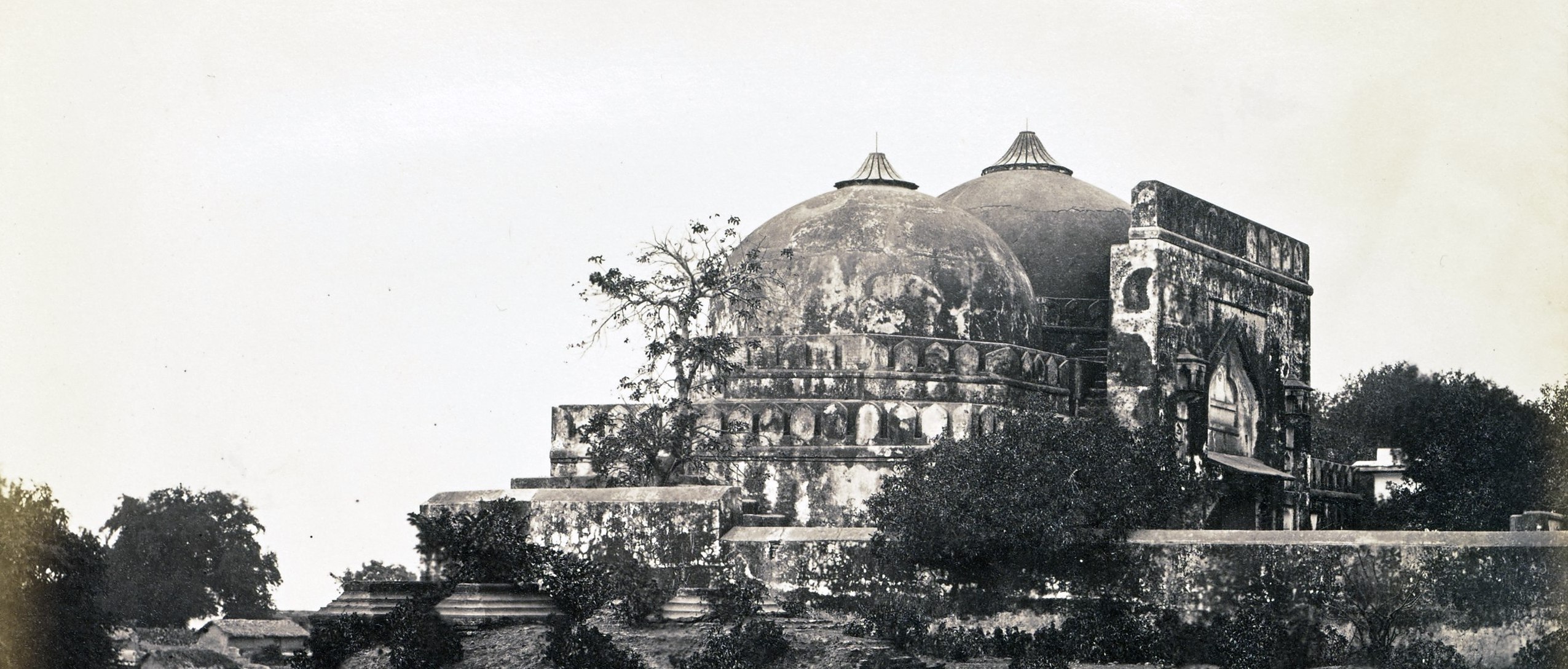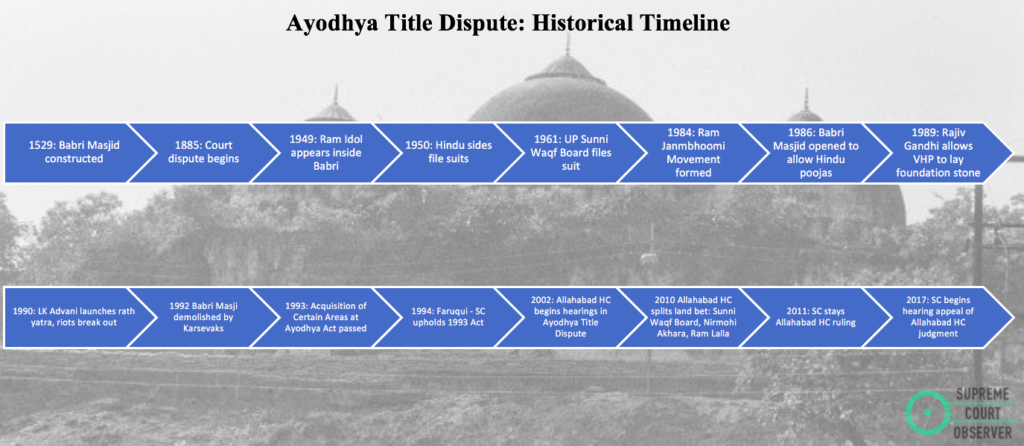Analysis
Timeline: Key Events in the Babri Masjid – Ram Mandir Controversy
Tracing the timeline of key events in the Babri Masjid- Ayodhya Title Dispute Case.

1529: Babri Mosque constructed by Mir Baqi.
1885: Court Dispute Begins – Mahant Raghubir Das files the first suit in the matter, seeking to build a temple on land adjoining the mosque. The Faizabad District Magistrate (DM) refuses him permission. Next, Mahant Raghubir Das files a title suit in Faizabad Court against the Secretary of State for India, seeking permission to build a temple on the chabutra (courtyard) of the Babri mosque. Faizabad Court rejects his plea.
Dec 1949: Ram Idol Appears inside the Mosque – On the night of December 22nd, a Ram Idol appears inside the mosque. Hindus see the appearance of the Idol as a divine revelation, however many argue that the Idol was smuggled inside at night. Hindus start offering prayers.
The Government declares the site a “contested area” and locks the entrance.
1950: Hindu sides file Suits – Two suits are filed in Faizabad Court by Gopal Simla Viharad and Paramhansa Ramachandra Das, seeking permission to conduct Hindu pujas to Ram Lalla. The Court granted the parties permission to conduct pujas. The Court orders the inner courtyard gates to remain locked.
1959: Third Hindu suit filed – Nirmohi Akhara files a third suit, seeking possession of the land.
1961: Muslim suit filed – UP Sunni Wakf Board files a suit seeking possession of Babri Mosque site. They also demand the removal of Ram Idols from Babri Masjid.
1984: Ram Janmbhoomi Movement commences – Vishwa Hindu Parishad (VHP) constitutes a group to start the Ram Janmbhoomi Movement. BJP leader LK Advani is made the leader of the campaign.
February 1st 1986: Inner Gate of Babri Mosque opened – A third party, lawyer UC Pandey appeals for the gates to be unlocked before the Faizabad Session Court, on the grounds that the Faizabad district administration, and not a Court, had ordered its closure.
District Judge orders the locks to be removed to allow Hindu “pooja and darshan”. Muslims constitute a Babri Mosque Action Committee (BMAC) in protest.
November 9th 1989: Shilanayas performed – PM Rajiv Gandhi allows the VHP to perform Shilanayas (laying of foundation stone) near the disputed area.
1989: All title suits shifted to Allahabad High Court. Another suit in name of Ram Lalla Virajman was filed in the High Court, naming the parties in the Nirmohi Akhara (1959) and Sunni Waqf Board (1961) suits as defendants.
September 25th 1990: Rath Yatra – LK Advani launches a Rath Yatra from Somnath (Gujarat) to Ayodhya (UP) to incite support for the Movement. Communal riots break out.
December 6th 1992: Babri demolished – Babri Mosque razed by a violent mob of Karsevaks. The Karsevaks leave behind a make-shift temple in its place.
December 16th 1992: Liberhan Commission formed – 10 days after the Mosque was demolished, the PM forms a committee led by retired High Court Justice M. S. Liberhan, to look into circumstances leading to the demolition of the Babri Mosque and the communal riots. The Commission was originally mandated to submit its report within three months of its formation.
January 7th 1993: State acquires Ayodhya land – Narsimha Rao Government issues an ordinance acquiring 67.7 acres of land (Site and adjoining areas). Later it was passed as a law – Acquisition of Certain Areas at Ayodhya Act, 1993 to facilitate the acquisition of land by the Central government.
1994: Ismail Faruqui Judgment – The SC by a majority of 3:2 upheld the constitutionality of Acquisition of Certain Areas at Ayodhya Act.
The majority judgment by former CJI J.S. Verma reasoned that every religious immovable property is liable to be acquired. The SC adjudged that offering namaz at mosque was not integral to Islam unless that mosque had any particular significance in Islam. The judgment has been criticized for regarding the mosque as a non-essential place of worship.
There were no reviews filed against Ismail Faruqui
April 2002: Ayodhya Title Dispute case begins – The Lucknow Bench of the Allahabad High Court begins hearing Ayodhya Title Dispute.
March – August 2003: ASI Survey – Archaeological Survey of India begins excavating the land underneath the disputed site under the directions of the Allahabad High Court. It claims to have found remnants of a 10th century Hindu Temple. Muslims question the ASI report.
June 30th 2009: Liberhan Commission report submitted – After a delay of 17 years, the Librehan Commission submits its report to the Prime Minister, though its contents are not made public.
September 30th 2010: Allahabad HC splits land in three ways – The High Court delivers its judgment, dividing the land between three parties: one third for the Sunni Wakf Board, one third for the Nirmohi Akhara and one third to Ram Lalla Virajman.
The Judgment of the Lucknow Bench of the HC on September 30, 2010, divided the disputed land in Ayodhya in 2:1 ratio among the Muslim and Hindu litigants.
The HC allotted the dome of the demolished Babri Masjid, under which the makeshift temple currently stands, to the Hindus. The structure was demolished by a group of Karsevaks on December 6, 1992. The nearby Ram Chabutra and Sita Rasoi also went to the Nirmohi Akhara. The one-third share of the Sunni Wakf Board comprises the outer courtyard of the disputed land.
May 2011: Supreme Court stays Allahabad High Court ruling – The SC admits a batch of petitions filed by all parties. A Division Bench of Aftam Alam and R.M. Lodha JJ term the High Court Judgment as “strange”. RM Lodha observes “a new dimension has been given by the High Court as the decree of partition was not sought by the parties. It was not prayed for by anyone. It has to be stayed. It’s a strange order. How can a decree for partition be passed when none of the parties had prayed for it?”
March 21th 2017: Former Chief Justice Khehar suggests an out of court settlement among all parties.
August 11th 2017: 3 judge bench of SC starts hearing the matter – The 3 judge bench of SC comprising Dipak Misra CJI, Ashok Bhushan and Abdul Nazeer JJ began hearing the appeal.
Feb – July 2018: The petitioners argue that the SC ought to refer the 1994 Ismail Faruqui judgment to a 7-judge Bench for reconsideration.
July 20th 2018: SC reserves verdict – The SC reserves judgment on the question of referring the appeal to a larger Bench
September 2th, 2018: SC refuses to form a larger Bench – The 3 judge bench in a split of 2:1 verdict held that the Ismail Faruqui judgment of 1994 does not require reconsideration by a larger bench.
January 8th 2019: CJI Gogoi forms a 5 judge Bench – Gogoi CJI used his administrative powers to list the matter before a 5 judge Constitution Bench, overturning the September 2018 judgment.
March 8th 2019: Supreme Court orders mediation – After two days of hearings, the Constitution Bench orders court-monitored mediation, despite the objection of some key parties. The mediation is set to end in mid-May 2019.

